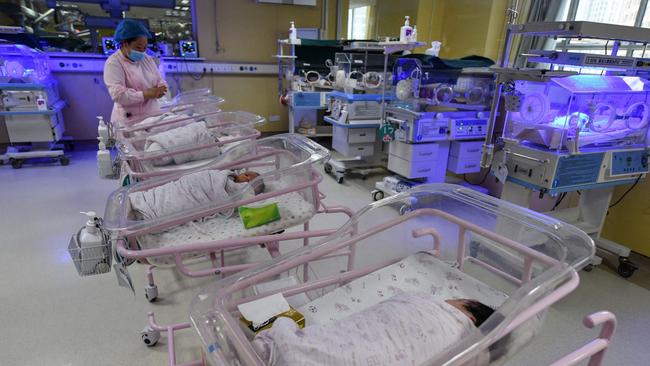Chinese birthrate falls to record low, after five years of decline
The number of newborns fell for a fifth straight year, to 10.62 million, barely outnumbering deaths.

The number of newborns in China fell for a fifth straight year to the lowest in modern Chinese history, despite Beijing’s increasing emphasis on encouraging births.
Last year’s 10.62 million births, down from 12.02 million in 2020, barely outnumbered the 10.14 million deaths, the National Bureau of Statistics said on Monday, suggesting the day may be near when China’s population starts to shrink. Some analysts believe the population may have already peaked.
At the end of 2021, China’s population was 1.413 billion, up only 0.034 per cent from the year earlier 1.412 billion at the end of 2020. The birthrate – the number of births per thousand people – slipped to a fresh low of 7.52 in 2021 compared with 8.52 in 2020, underscoring Beijing’s challenge in brightening a dire demographic picture.
Since a rise in 2016, when China scrapped the four-decade one-child policy and allowed married couples to have two children, the number of births has slipped every year. The birthrate was already the lowest in the country’s modern history in 2019.
Nearly one in five Chinese is 60 or older. Monday’s data showed a further rise in that percentage, to 18.9 per cent in 2021 from 18.7 per cent in 2020.
“The demographic challenge is well known but the speed of population ageing is clearly faster than expected,” Zhiwei Zhang, an economist at Pinpoint Asset Management, said in a note. This suggests that China’s total population may have reached its peak in 2021, Mr Zhang said.
Working-age Chinese – defined as those aged between 16 and 59 – now account for 63 per cent of the total population.
China, which just a few short years ago harshly restricted how many children couples could have, now struggles to persuade them to have more. Since Beijing last year said all couples could have three children, local governments have tried measures including cash rewards and longer maternity leaves to boost births. To facilitate marriages, officials have organised matchmaking events and discouraged the use of dowries. These efforts haven’t seemed to yield significant results. China’s marriage registrations, after declining sharply in 2020, continued to drop over the first nine months of last year, the latest official data showed.
More young women give their careers a higher priority than starting a family, moving away from values touted by the government and older generations.
A gender imbalance also contributes to falling marriage rates, said He Yafu, an independent demographer based in Guangdong. A traditional preference for boys combined with the now-scrapped one-child policy have skewed China’s sex ratio. Among Chinese ages 20 to 40, men outnumber women by 17.5 million, census data showed, although nationwide the gap has narrowed in recent years.
Officials have attributed the low birth numbers partly to Covid-19 uncertainty. For two years, China has used some of the strictest measures anywhere to keep Covid-19 out, taking a toll on its people and economy.
But researchers and officials also point to underlying factors, such as the dwindling number of women of child-bearing age, that suggest low births have become a new normal. Other major economies have also had sluggish population growth during the pandemic.
China’s fertility rate – the number of children a woman has over her lifetime – dropped below replacement levels in the early 1990s and in 2020 came in at 1.3, below even Japan’s 1.34. Japan’s rate, among the world’s lowest, began to recover with government support after dipping to a record low of 1.26 in 2005, though in recent years it has started falling again.
Highlighting the sensitivity of the issue surrounding demographics, China suspended the social media account of a popular Chinese economist days after an article of his suggesting that the country spend $US314bn to boost its fertility rate went viral online.
To address rising demographic challenges, the central government has said it would adopt measures such as raising the statutory retirement age, but has yet to do so.
The Wall Street Journal



To join the conversation, please log in. Don't have an account? Register
Join the conversation, you are commenting as Logout